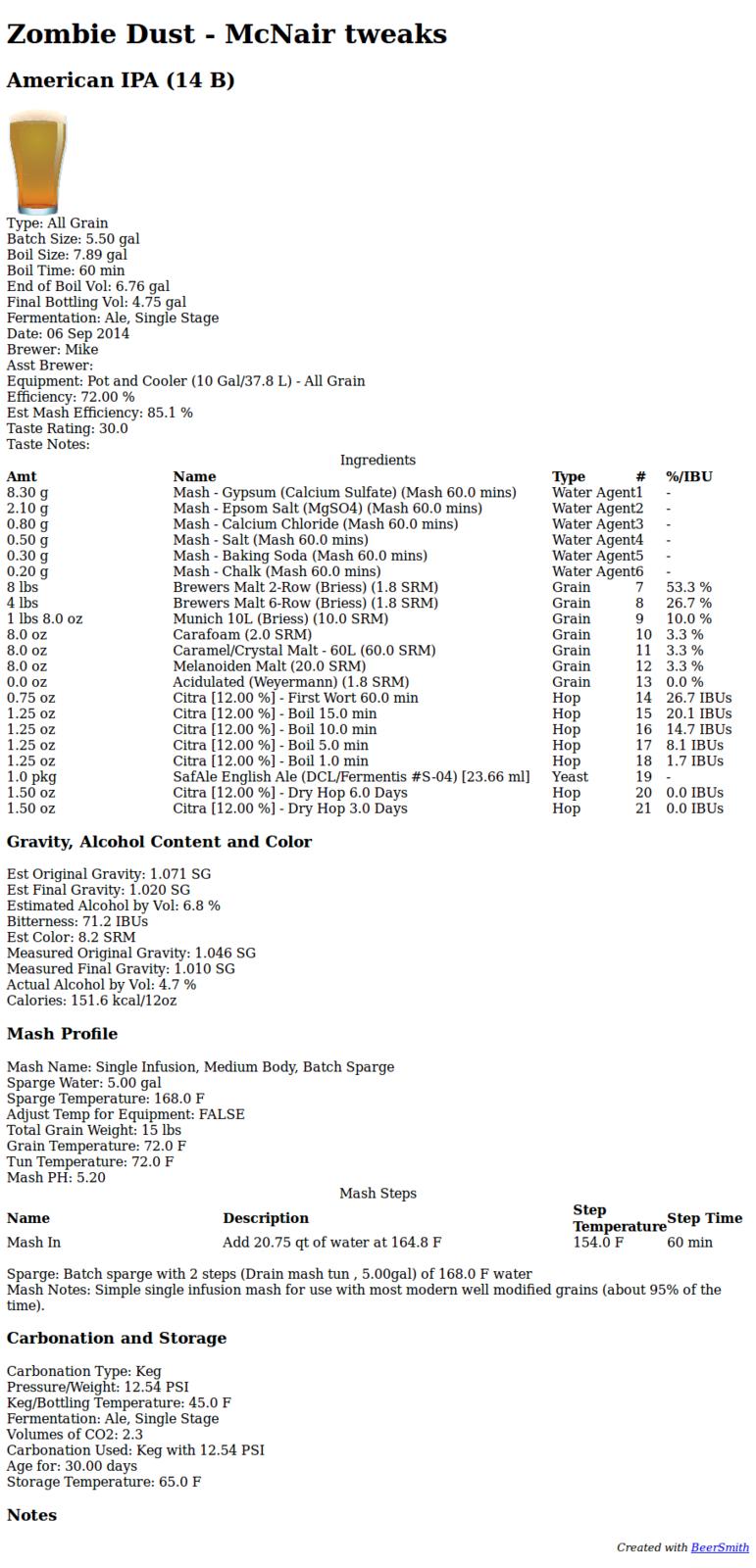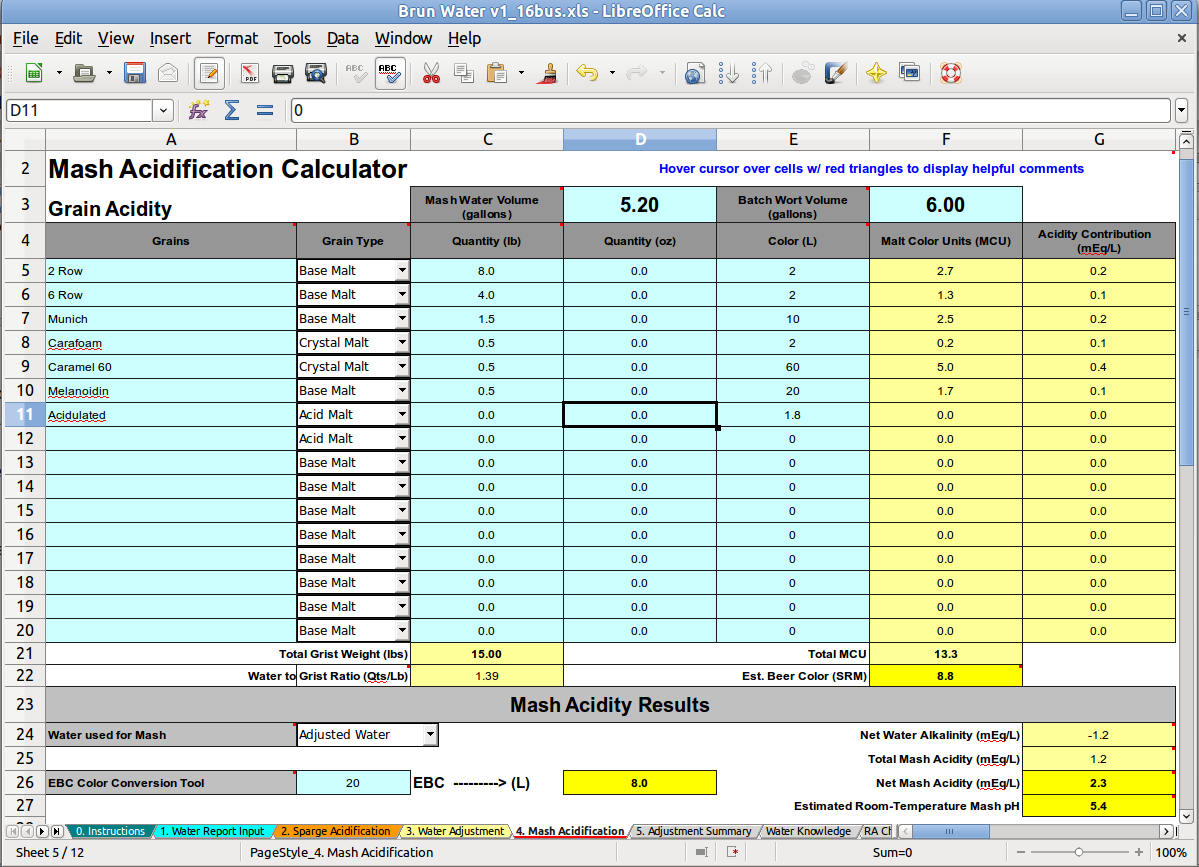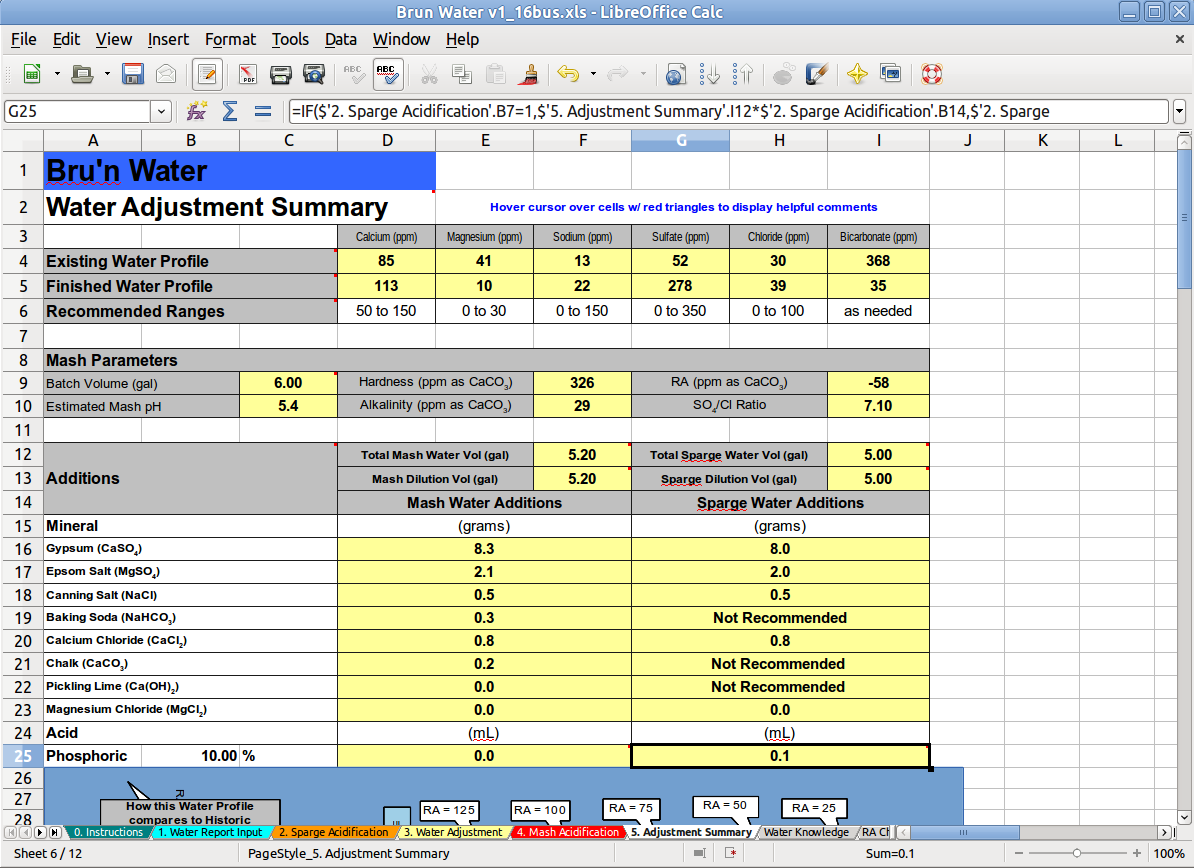I finally watched John's youtube as well and while I have brewed the HT clone 3 times and it always came out great, I never paid attention to my mash pH. My mash pH calculates to 5.77 on brewersfriend, but adding 2 tsp of gypsum to the mash and using 2% acidulated malt should drop my mash pH to 5.4 as well as giving me the ideal mineral levels (outside of the high sodium levels my water supply has) for a light colored and hoppy beer. I think I'll go with hop shots and only dry hop for 4-5 days next time I do the Heady clone and see how much better I can get it.
You are using an out of date browser. It may not display this or other websites correctly.
You should upgrade or use an alternative browser.
You should upgrade or use an alternative browser.
Mash pH
- Thread starter PlinyTheMiddleAged
- Start date

Help Support Homebrew Talk:
This site may earn a commission from merchant affiliate
links, including eBay, Amazon, and others.
PlinyTheMiddleAged
Well-Known Member
- Joined
- Jan 9, 2014
- Messages
- 377
- Reaction score
- 106
Unearthly,
Thanks for bumping this thread to the top of the queue. In reviewing it, I realized that I never posted my tasting notes about my two one gallon batches of Zombie Dust. I mashed one at 5.29 and the second at 5.45. The unanimous conclusion was that the 5.45 was far superior of the two. The 5.29 was too acidic - too "bright" for an IPA. I was shocked at the difference between the two.
Of course, that was mash pH. In the heat of the moment, I never checked kettle pH. So, perhaps the 5.29 mash measurement was off (too high) or for some odd reason the kettle pH was much lower. Regardless, ever since this little taste off, I've been shooting for 5.40 mash pH - last week I got a mash pH of 5.43 on my Two Hearted clone.
Thanks for bumping this thread to the top of the queue. In reviewing it, I realized that I never posted my tasting notes about my two one gallon batches of Zombie Dust. I mashed one at 5.29 and the second at 5.45. The unanimous conclusion was that the 5.45 was far superior of the two. The 5.29 was too acidic - too "bright" for an IPA. I was shocked at the difference between the two.
Of course, that was mash pH. In the heat of the moment, I never checked kettle pH. So, perhaps the 5.29 mash measurement was off (too high) or for some odd reason the kettle pH was much lower. Regardless, ever since this little taste off, I've been shooting for 5.40 mash pH - last week I got a mash pH of 5.43 on my Two Hearted clone.
Keep experimenting. Don't conclude that 5.4 is optimum based on a single brew session. It is very hard for home brewers to control things from brew to brew well enough that we can vary one and only one parameter. Try other pH's as well as 5.4. If you consistently find that 5.4 gives you the best result then and only then conclude that this is the optimum pH for this beer. Try 5.5 and 5.6 too. We should all do this but of course most of us don't because we don't brew the same beer that many times.
Keep experimenting. Don't conclude that 5.4 is optimum based on a single brew session. It is very hard for home brewers to control things from brew to brew well enough that we can vary one and only one parameter. Try other pH's as well as 5.4. If you consistently find that 5.4 gives you the best result then and only then conclude that this is the optimum pH for this beer. Try 5.5 and 5.6 too. We should all do this but of course most of us don't because we don't brew the same beer that many times.
I found that I prefer a mash pH of 5.4ish for my IPAs as well. At least, the ones I"ve done over and over. I think it really has "bright" flavors that way, for lack of a better term. Since I brew mostly APAs, IPAs, and American reds with a blonde or a lager tossed in the mix, that was a big "Aha!" moment for me.
For sure, keep experimenting. Taste preferences are a personal thing. However, there are now thousands of accounts from brewers worldwide that can be generalized here. For hop-focused, bittered beers, somewhere around 5.4 is more likely to produce a pleasing flavor. In malt-focused beers, targeting a slightly lower pH of around 5.2 tends to be more pleasing. For most roast-focused beers, a slightly higher pH of around 5.5 to 5.6 tends to be most pleasing. In all cases, don't let this guidance be the end of your quest. Try moving the pH a bit higher or lower to find that spot that best meets YOUR expectations and tastes.
Enjoy!
Enjoy!

$28.98
Five Star - 6022b_ - Star San - 32 Ounce - High Foaming Sanitizer
Great Fermentations of Indiana

$159.50 ($26.58 / Count)
3M High Flow Series System BREW120-MS, 5616001, For Brewed Coffee and Hot Tea, Valve-in-Head Design
Amazon.com

$53.24
1pc Hose Barb/MFL 1.5" Tri Clamp to Ball Lock Post Liquid Gas Homebrew Kegging Fermentation Parts Brewer Hardware SUS304(Liquid Hose Barb)
yunchengshiyanhuqucuichendianzishangwuyouxiangongsi

$58.16
HUIZHUGS Brewing Equipment Keg Ball Lock Faucet 30cm Reinforced Silicone Hose Secondary Fermentation Homebrew Kegging Brewing Equipment
xiangshuizhenzhanglingfengshop

$719.00
$799.00
EdgeStar KC2000TWIN Full Size Dual Tap Kegerator & Draft Beer Dispenser - Black
Amazon.com

$33.99 ($17.00 / Count)
$41.99 ($21.00 / Count)
2 Pack 1 Gallon Large Fermentation Jars with 3 Airlocks and 2 SCREW Lids(100% Airtight Heavy Duty Lid w Silicone) - Wide Mouth Glass Jars w Scale Mark - Pickle Jars for Sauerkraut, Sourdough Starter
Qianfenie Direct

$176.97
1pc Commercial Keg Manifold 2" Tri Clamp,Ball Lock Tapping Head,Pressure Gauge/Adjustable PRV for Kegging,Fermentation Control
hanhanbaihuoxiaoshoudian

$10.99 ($31.16 / Ounce)
Hornindal Kveik Yeast for Homebrewing - Mead, Cider, Wine, Beer - 10g Packet - Saccharomyces Cerevisiae - Sold by Shadowhive.com
Shadowhive

$479.00
$559.00
EdgeStar KC1000SS Craft Brew Kegerator for 1/6 Barrel and Cornelius Kegs
Amazon.com

$7.79 ($7.79 / Count)
Craft A Brew - LalBrew Voss™ - Kveik Ale Yeast - For Craft Lagers - Ingredients for Home Brewing - Beer Making Supplies - (1 Pack)
Craft a Brew

$20.94
$29.99
The Brew Your Own Big Book of Clone Recipes: Featuring 300 Homebrew Recipes from Your Favorite Breweries
Amazon.com

$22.00 ($623.23 / Ounce)
AMZLMPKNTW Ball Lock Sample Faucet 30cm Reinforced Silicone Hose Secondary Fermentation Homebrew Kegging joyful
无为中南商贸有限公司

$53.24
1pc Hose Barb/MFL 1.5" Tri Clamp to Ball Lock Post Liquid Gas Homebrew Kegging Fermentation Parts Brewer Hardware SUS304(Liquid Hose Barb)
Guangshui Weilu You Trading Co., Ltd

$76.92 ($2,179.04 / Ounce)
Brewing accessories 1.5" Tri Clamp to Ball Lock Post Liquid Gas Homebrew Kegging Fermentation Parts Brewer Hardware SUS304 Brewing accessories(Gas Hose Barb)
chuhanhandianzishangwu

$44.99
$49.95
Craft A Brew - Mead Making Kit – Reusable Make Your Own Mead Kit – Yields 1 Gallon of Mead
Craft a Brew
PlinyTheMiddleAged
Well-Known Member
- Joined
- Jan 9, 2014
- Messages
- 377
- Reaction score
- 106
Thanks ladies and gentlemen!
I've been focusing on trying to get drinkable American pale ales and IPAs - and yes, I think I have pretty tough standards. Thus far, I've brewed Two Hearted and Zombie Dust clones over and over again. Other than the little one gallon experiment, I've been shooting for a pH of 5.4. I have discovered that post fermentation exposure of my finished beers during the bottling step has been the cause of many (most?) of my problems. Once I address that issue adequately (I think a keg is in my near future), I'll meddle more with pH. One thing at a time, right?
And thanks again for all the help that the board has provided!
I've been focusing on trying to get drinkable American pale ales and IPAs - and yes, I think I have pretty tough standards. Thus far, I've brewed Two Hearted and Zombie Dust clones over and over again. Other than the little one gallon experiment, I've been shooting for a pH of 5.4. I have discovered that post fermentation exposure of my finished beers during the bottling step has been the cause of many (most?) of my problems. Once I address that issue adequately (I think a keg is in my near future), I'll meddle more with pH. One thing at a time, right?
And thanks again for all the help that the board has provided!
I realized that I never posted my tasting notes about my two one gallon batches of Zombie Dust. I mashed one at 5.29 and the second at 5.45. The unanimous conclusion was that the 5.45 was far superior of the two.
Would you please share what additions you made to your RO water for your 5.45 pH batch, perhaps scaled up to a 5.5 gallon batch? I have all the ingredients to brew the Zombie Dust clone, and I'm just waiting for a free day to brew it. A water recipe would be most helpful. Thanks.
PlinyTheMiddleAged
Well-Known Member
- Joined
- Jan 9, 2014
- Messages
- 377
- Reaction score
- 106
Would you please share what additions you made to your RO water for your 5.45 pH batch, perhaps scaled up to a 5.5 gallon batch? I have all the ingredients to brew the Zombie Dust clone, and I'm just waiting for a free day to brew it. A water recipe would be most helpful. Thanks.
Will do! It'll be a few hours until I get to my notes. I'll post later today.
PlinyTheMiddleAged
Well-Known Member
- Joined
- Jan 9, 2014
- Messages
- 377
- Reaction score
- 106
Would you please share what additions you made to your RO water for your 5.45 pH batch, perhaps scaled up to a 5.5 gallon batch? I have all the ingredients to brew the Zombie Dust clone, and I'm just waiting for a free day to brew it. A water recipe would be most helpful. Thanks.
MikeInMKE,
How much water will you be using in your mash and sparge? Knowing that, I'll know how to adjust the salt additions that I used to your volumes.
I do a BIAB process with a sparge - usually about half the pre-boil volume for the mash and the other half for the sparge. If your process is different than that, your salts will also differ.
Given the above, I'll share what I did (along with my grist in case yours differs). I suggest you pick up a copy of Bru'n Water (free version works great but the paid is better). You can plug in your particular grist along with your mash/sparge volumes, your target profile, and it then becomes pretty easy to figure out your additions.
PlinyTheMiddleAged
Well-Known Member
- Joined
- Jan 9, 2014
- Messages
- 377
- Reaction score
- 106
OK. Here goes. I'm going to (try to) share some pictures from my version of Bru'n Water. I'll start off with a listing of the grist that I used for the version of Zombie Dust that I brewed.
The first picture is a screenshot of the "Mash Acidification" tab. Hopefully, the grain bill will look familiar to you (but given that this was for a 1 gallon batch, your weights will be approximately 5.5x bigger) - see the area circled in red. Given the grain bill alone, you really can't know anything about the resulting mash pH. Without any salts added and using 100% distilled water (this will be obvious on my second screen shot), Bru'n Water estimates a mash pH of 5.56 - see the area in the lower right circled in green. Don't worry, we'll fix this in the next step.
With this tab properly filled out, the next tab you should attend to is the "Water Adjustment" tab - see the second picture. On this tab, you add your salts with two goals in mind - 1) hit your "Desired Water Profile" (see the upper left corner of the "Water Adjustment" tab where I have circled in red) and 2) hit your mash pH. You do this by adding the various salts that I have indicated in the green circled area. In the second screenshot, I have not yet added anything so you see a bunch of zeros in the green circled area and you see that the mash pH is off (as was seen on the previous screenshot). In this screenshot, I have already entered my mash and sparge volumes - see the area circled in orange. Also note that I have assumed that I am working with 100% distilled water - note the area below the red circled area and to the right hand side of the spreadsheet.
Now I start adding salts - see the third screenshot. Keep your eye on the two goals of Profile and pH. It's a trial and error process really. Simply make a change and see what happens (don't worry here - you can't screw up a beer by playing with a spreadsheet). Change a salt addition and watch what happens to your two targets. When you get close to your target water profile AND your target pH, you're done - see the third screenshot. I got pretty close to the desired water profile (the area circled in red) and my target pH (the area circled in green). The required additions for the mash and sparge additions are circled in orange.
I hope this is clear enough as to what I did - it is to me (but I'm just now finishing a ZD clone that is quite delicious). I highly recommend picking up the paid version of Bru'n Water (you decide how much it is worth to you - hint: it is worth more than you think). The screenshots that I have provided are from the paid version. I'm pretty sure that you get two decimal points on the estimated pH on the "Mash Acidification" tab. I like knowing that I'm not working at a mash pH somewhere between 5.35 and 5.44 when I'm shooting for 5.40; I like to see that I am pretty darn close. In this case, the final screenshot shows that I am at an estimated pH of 5.41 - see the fourth screenshot in the red circled area.
It is NOT as complex as it may first appear to be. Go through it once or twice just to exercise the spreadsheet, and you'll be fine. Another option is just to go with the water primer for your first couple of water adjustment attempts.
You know what? This ZD is pretty good! I think I'll have another!

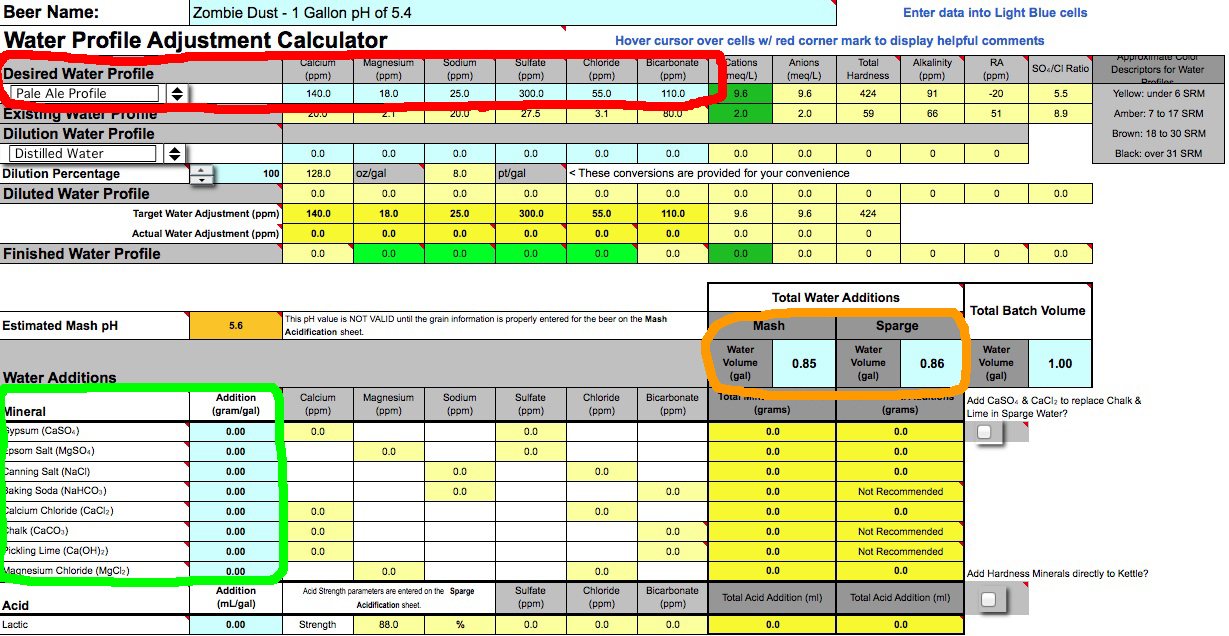

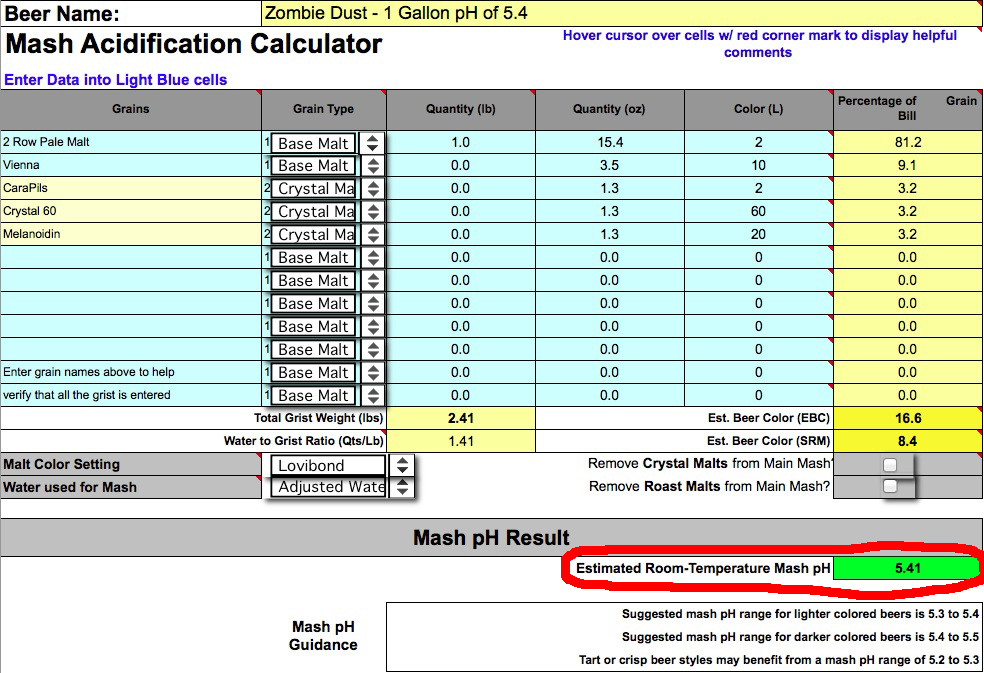
The first picture is a screenshot of the "Mash Acidification" tab. Hopefully, the grain bill will look familiar to you (but given that this was for a 1 gallon batch, your weights will be approximately 5.5x bigger) - see the area circled in red. Given the grain bill alone, you really can't know anything about the resulting mash pH. Without any salts added and using 100% distilled water (this will be obvious on my second screen shot), Bru'n Water estimates a mash pH of 5.56 - see the area in the lower right circled in green. Don't worry, we'll fix this in the next step.
With this tab properly filled out, the next tab you should attend to is the "Water Adjustment" tab - see the second picture. On this tab, you add your salts with two goals in mind - 1) hit your "Desired Water Profile" (see the upper left corner of the "Water Adjustment" tab where I have circled in red) and 2) hit your mash pH. You do this by adding the various salts that I have indicated in the green circled area. In the second screenshot, I have not yet added anything so you see a bunch of zeros in the green circled area and you see that the mash pH is off (as was seen on the previous screenshot). In this screenshot, I have already entered my mash and sparge volumes - see the area circled in orange. Also note that I have assumed that I am working with 100% distilled water - note the area below the red circled area and to the right hand side of the spreadsheet.
Now I start adding salts - see the third screenshot. Keep your eye on the two goals of Profile and pH. It's a trial and error process really. Simply make a change and see what happens (don't worry here - you can't screw up a beer by playing with a spreadsheet). Change a salt addition and watch what happens to your two targets. When you get close to your target water profile AND your target pH, you're done - see the third screenshot. I got pretty close to the desired water profile (the area circled in red) and my target pH (the area circled in green). The required additions for the mash and sparge additions are circled in orange.
I hope this is clear enough as to what I did - it is to me (but I'm just now finishing a ZD clone that is quite delicious). I highly recommend picking up the paid version of Bru'n Water (you decide how much it is worth to you - hint: it is worth more than you think). The screenshots that I have provided are from the paid version. I'm pretty sure that you get two decimal points on the estimated pH on the "Mash Acidification" tab. I like knowing that I'm not working at a mash pH somewhere between 5.35 and 5.44 when I'm shooting for 5.40; I like to see that I am pretty darn close. In this case, the final screenshot shows that I am at an estimated pH of 5.41 - see the fourth screenshot in the red circled area.
It is NOT as complex as it may first appear to be. Go through it once or twice just to exercise the spreadsheet, and you'll be fine. Another option is just to go with the water primer for your first couple of water adjustment attempts.
You know what? This ZD is pretty good! I think I'll have another!





OK. Here goes. I'm going to (try to) share some pictures from my version of Bru'n Water. I'll start off with a listing of the grist that I used for the version of Zombie Dust that I brewed.
Interesting post - good description of the process.
Working from this recipe, with a few minor changes, the Zombie Dust recipe in BeerSmith, with water adjustments in Brun Water:


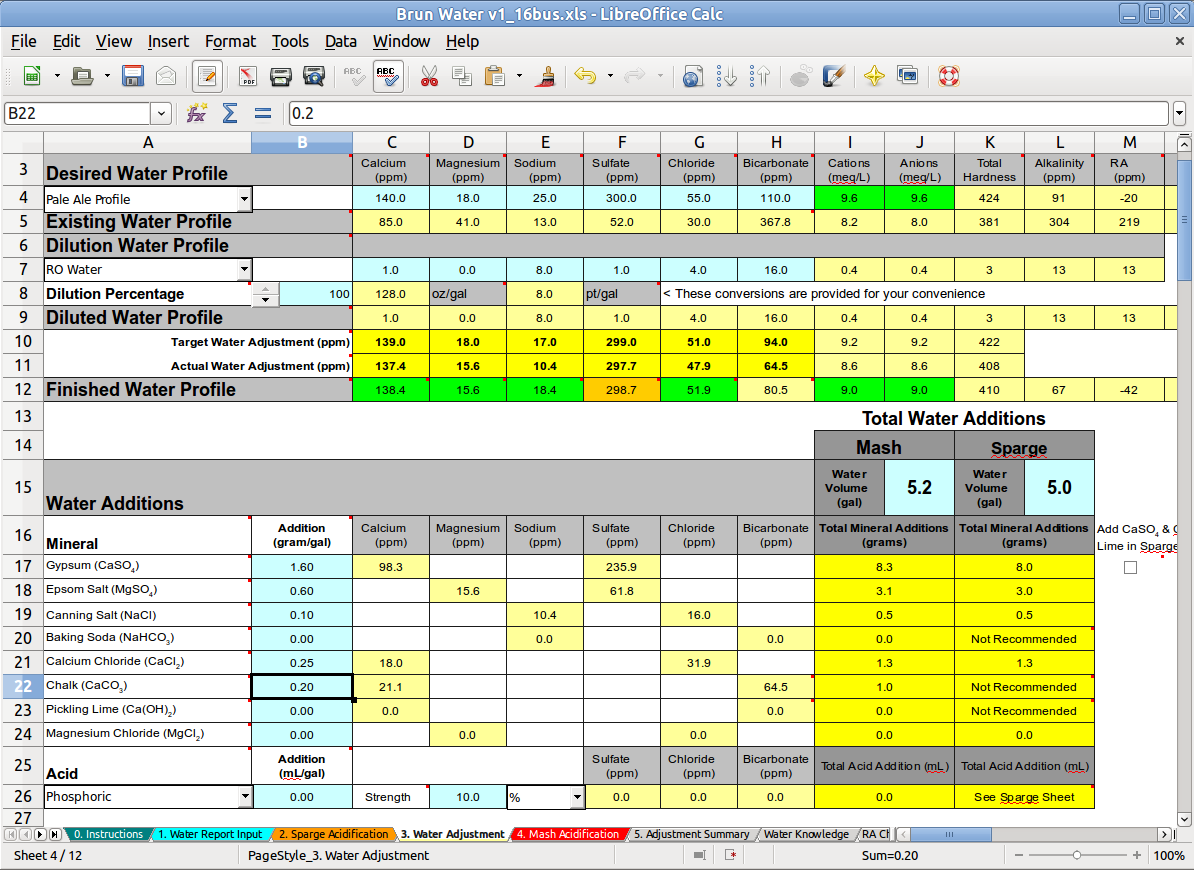
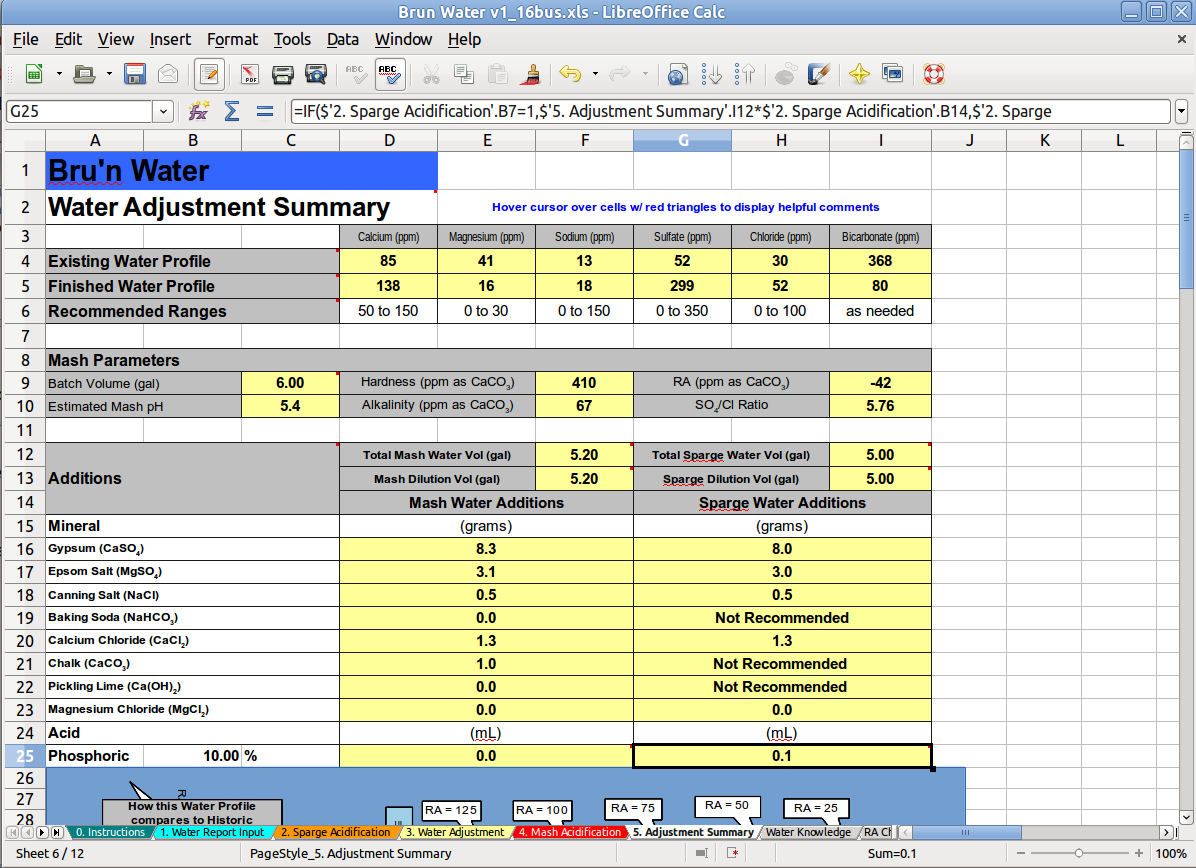




PlinyTheMiddleAged
Well-Known Member
- Joined
- Jan 9, 2014
- Messages
- 377
- Reaction score
- 106
MikeInMKE,
Looks good to me. The additions are bringing you in line with your targeted profile. And more importantly, your pH is right where it needs to be.
Good luck!
Looks good to me. The additions are bringing you in line with your targeted profile. And more importantly, your pH is right where it needs to be.
Good luck!
laxsoccerguy
Well-Known Member
I found that I prefer a mash pH of 5.4ish for my IPAs as well. At least, the ones I"ve done over and over. I think it really has "bright" flavors that way, for lack of a better term. Since I brew mostly APAs, IPAs, and American reds with a blonde or a lager tossed in the mix, that was a big "Aha!" moment for me.
Is this a Mash PH on the HOT side (mash temP) or cooled down to room temp?
laxsoccerguy
Well-Known Member
nvm, I see now. thanks!
rideincircles
Well-Known Member
I measured my Russian Imperial Stout Mash PH at 4.18 yesterday. It had 19 lbs of British 2-row and 4 lbs of specialty malts. Would there be any normal reason it would be this low. I have not calibrated my PH meter, but it is the red/black one. Normally Fort Worth brewing water is fine. I don't have a charcoal filter.
Normally I haven't paid much attention to the mash ph, but this seemed really low. I did add potasssium metabisulfite to the water before boiling, and I recall that some of the water I had boiling left a lot of white residue at the rim that had boiled down.
I made a run off porter batch that ended up with 3 gallons at 1.040 and it was really astringent. Would this be caused by the low ph? My mash was at 154 pretty much the whole way and I sparged with 170-172 degree water and the porter was pretty much all 170 sparge water.
Also, I just checked my tap water and it measures at 7.3. I checked by adding a few pinches of metabisulfite and it dropped to 5.8. I think that may be the reason, but I did not add a huge amount, although I didn't measure it specifically.
Normally I haven't paid much attention to the mash ph, but this seemed really low. I did add potasssium metabisulfite to the water before boiling, and I recall that some of the water I had boiling left a lot of white residue at the rim that had boiled down.
I made a run off porter batch that ended up with 3 gallons at 1.040 and it was really astringent. Would this be caused by the low ph? My mash was at 154 pretty much the whole way and I sparged with 170-172 degree water and the porter was pretty much all 170 sparge water.
Also, I just checked my tap water and it measures at 7.3. I checked by adding a few pinches of metabisulfite and it dropped to 5.8. I think that may be the reason, but I did not add a huge amount, although I didn't measure it specifically.
Defective pH meter or one that was way out of calibration.I measured my Russian Imperial Stout Mash PH at 4.18 yesterday. It had 19 lbs of British 2-row and 4 lbs of specialty malts. Would there be any normal reason it would be this low.
Not sure what the relevance of the color of the meter is. If it hasn't been calibrated in a long time it is virtually useless or perhaps worse than useless as it may cause you to draw erroneous conclusions regarding correction.I have not calibrated my PH meter, but it is the red/black one.
It is. Even if you added 4 pounds of sauermalz to 19 pounds of a typical base malt you wouldn't get to pH 4.18.Normally I haven't paid much attention to the mash ph, but this seemed really low.
I assume this means you added a couple of tenths of a gram or so for chloramine control.I did add potasssium metabisulfite to the water before boiling,
Unless you added a lot of acid to your water you never got near pH 4.18 so I'll say no.Would this be caused by the low ph?
Also, I just checked my tap water and it measures at 7.3. I checked by adding a few pinches of metabisulfite and it dropped to 5.8. I think that may be the reason, but I did not add a huge amount, although I didn't measure it specifically.
Metabite is acidic (it releases sulfurous acid) but you'd have to add grams of it to a few gal of water to get anywhere near pH 4. If you did do that I can't begin to predict what the results might be beyond pretty bad beer.
rideincircles
Well-Known Member
Cool. Thanks. I am still not sure as to why my measurement seemed so low, but the dark malts were near the top of the mash tun while the regular grain was mostly at the bottom. THat may have affected the number I got. I did not check it again.
Fermentation has now started on my stout. As far as the run off batch, I assume I may have started pulling some tannins or something along the lines out of the mash. The stout didn't seem to have the problem. I will now wait for months for the final results.
Fermentation has now started on my stout. As far as the run off batch, I assume I may have started pulling some tannins or something along the lines out of the mash. The stout didn't seem to have the problem. I will now wait for months for the final results.
Dark malts will not give a pH as low as 4.18. In case you missed the point, an uncalibrated pH meter is worthless.
roncruiser
Well-Known Member
One of the better threads I've come across on mash PH. Not hundreds of replies long. No noise. Solid precise information. An excellent read. 

gifty74
Well-Known Member
Well, I wrote John an email a few hours ago and this is what I got back:
"Jeff, those are a target for hot side.
John Kimmich
By "hot side" are you sure he's not referring to the boil kettle (often referred to as the hot side) and not that the pH is measured hot (i.e. At mash temps)??
PlinyTheMiddleAged
Well-Known Member
- Joined
- Jan 9, 2014
- Messages
- 377
- Reaction score
- 106
Well, given the pH ranges that he mentions in his talk, I'd say those are at mash temps. But since he didn't say mash temps, I can't be certain. Brew the same beer at two different pH and let us know what you think.
gifty74
Well-Known Member
Agreed. Right before that he says "I cannot stress enough the importance of treating your mash water." So ok, he's definitely talking mash pH.
What's more odd is he says "if you are not hitting between 5.1 & 5.3 you're at a disadvantage. If you're over 5.3, you're at a serious disadvantage. If you come in under it's much more forgiving. You can have an acidic mash, and still have a beautiful bright crisp nice beer at the end. If you're up in that 5.4, 5.5 5.6...forget it, it's going to be a muddled piece of sh*t."
Pretty interesting, when the common target for an IPA seems to be a consensus 5.4 on this forum. But, if he's talking in terms of those pH's measured "hot", we should be adding 0.3 units as we are mostly talking in terms of room temp mash pH's.
What's more odd is he says "if you are not hitting between 5.1 & 5.3 you're at a disadvantage. If you're over 5.3, you're at a serious disadvantage. If you come in under it's much more forgiving. You can have an acidic mash, and still have a beautiful bright crisp nice beer at the end. If you're up in that 5.4, 5.5 5.6...forget it, it's going to be a muddled piece of sh*t."
Pretty interesting, when the common target for an IPA seems to be a consensus 5.4 on this forum. But, if he's talking in terms of those pH's measured "hot", we should be adding 0.3 units as we are mostly talking in terms of room temp mash pH's.
I brewed a Rye Saison yesterday with the grist info and mineral additions shown below. I estimated room-temp mash pH using three different calculators: Bru'n = 5.37, Brewers Friend = 5.57, EZ = 5.59. I went with Bru'n on this one and I'm interested to see how it turns out due to variance of ~0.2 pH value. I observed fast and efficient mash conversion. Also achieved better than expected brewhouse efficiency at 76%. Due to rye inclusion and dunk sparge without squeezing I expected low 70s at best.
RYE SAISON
82% - 3.3 kg (7.3lb) 2 Row 1.75L
10% - 0.4 kg (0.88lb) Rye 3.5L
7% - 0.29 kg (0.64lb) Munich 12L
1% - 0.04 kg (0.09lb) Black Patent 525L
- Mash water: 11.36L (3 gal), Sparge 15.1L (4 gal).
- Used 100% RO (Ca:1; Na:8; SO4:1; Cl:4, bicarb:16) and treated ALL water at 0.18 g/L Gypsum + 0.13 g/L CaCl2. Also 0.5 ml 88% Lactic acid to mash only. Spreadsheets disagree on final mineral concentration, but Bru'n estimates Ca: 89; SO4: 100; Cl: 83.
This is my first time treating sparge water and going with the lower estimate (i.e.: adding less acid: 0.5ml instead of 2.7ml). All went well and it will be interesting to see how this turns out!
RYE SAISON
82% - 3.3 kg (7.3lb) 2 Row 1.75L
10% - 0.4 kg (0.88lb) Rye 3.5L
7% - 0.29 kg (0.64lb) Munich 12L
1% - 0.04 kg (0.09lb) Black Patent 525L
- Mash water: 11.36L (3 gal), Sparge 15.1L (4 gal).
- Used 100% RO (Ca:1; Na:8; SO4:1; Cl:4, bicarb:16) and treated ALL water at 0.18 g/L Gypsum + 0.13 g/L CaCl2. Also 0.5 ml 88% Lactic acid to mash only. Spreadsheets disagree on final mineral concentration, but Bru'n estimates Ca: 89; SO4: 100; Cl: 83.
This is my first time treating sparge water and going with the lower estimate (i.e.: adding less acid: 0.5ml instead of 2.7ml). All went well and it will be interesting to see how this turns out!
Biscuits
Well-Known Member
I am curious now about how no sparge BIAB'er are effected by this? I mean, by treating all of my liquor and targeting a mash pH of 5.4 (or whatever), typically the kettle pH will start out the same. Should the pH in the kettle then be adjusted? I have read through this thread and I am still not understanding what the target kettle pH should be and at what temperature.
Similar threads
- Replies
- 60
- Views
- 2K
- Replies
- 12
- Views
- 542
- Replies
- 18
- Views
- 773
- Replies
- 13
- Views
- 778








































![Craft A Brew - Safale BE-256 Yeast - Fermentis - Belgian Ale Dry Yeast - For Belgian & Strong Ales - Ingredients for Home Brewing - Beer Making Supplies - [3 Pack]](https://m.media-amazon.com/images/I/51bcKEwQmWL._SL500_.jpg)

